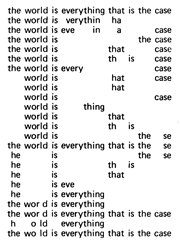Articles
- Poetry: Recognising poetic form
- Historical aspects
- Stylistic aspects
Concrete poetry
Definition
Concrete poetry emphasises the form and visual appearance of a poem so that its shape is in some way expressive of its subject matter. In concrete poetry, typographical arrangement is therefore as important (sometimes more important) than language, metaphor or metre in expressing meaning.
Early use
Concrete images can be found in the work of early poets, as in this verse from a poem by George Herbert (1593-1633):
Lord, who createdst man in wealth and store,
Though foolishly he lost the same,
Decaying more and more,
Till he became
Most poore:
With thee
O let me rise
As larks, harmoniously,
And sing this day thy victories:
Then shall the fall further the flight in me.
The poem is called Easter-wings and if the text is turned through ninety degrees it resembles the shape of a bird's (or angel's) wings, fitting for a poem about falling and rising like a lark. In the first edition of Herbert's poem, the second verse was printed on the facing page and gave the sense of more than one bird with outstretched wings. The key words ‘With thee', expressing Herbert's faith in God, are placed at the very centre of the poem.
Modern examples
Concrete poetry as an organised movement can be dated to the 1950s and 1960s, a period when many forms of experimental poetry flourished. Here is a modern example from the work of the Scottish poet, Edwin Morgan (1920-2010):

- The poem begins by quoting a famous statement from the work of Ludwig Wittgenstein (1889-1951), one of the leading philosophers of the twentieth century: ‘The world is everything that is the case'.
- In successive lines Morgan omits one or more letters from this statement to produce a series of further statements, each of them in some way relevant to Wittgenstein's original assertion.
- Some of them subvert the idea (‘the world is … the case', ‘the world is … that … case'); others are comic (‘the world is … verythin … ha', ‘… h..o…ld … everything'); while others again are more troubling or puzzling (‘the world is eve… in … a …case', ‘he … is eve …').
- In each of these variations (concrete poetry can have something in common with music) Morgan's intention seems to be to make the reader think about Wittgenstein's statement in a different way and not to accept it as a universal truth that cannot be challenged or altered.
Ian Hamilton Finlay (1925-2006), also a Scotsman, was the other notable recent exponent of concrete poetry in English. He worked in art forms other than poetry and fiction, including print-making and sculpture, a literally concrete form of expression. Finlay created a notable garden at his home in Scotland Little Sparta, Lanarkshire), which he filled with his own works, many of them inscribed sculptures. Here is his poem Acrobats:

- This poem is based on a single word, ‘acrobats', and uses its eight letters (each of which occupies a single horizontal line) to create a complex pattern.
- The word can be read in a number of different directions, both vertically and diagonally, or be recreated by moving one of the vertical lines to the left.
- At the same time the patterning of the letters of the whole surface area suggests the movements of the acrobats as they perform their routines.
Intention
As can be seen from these three examples, concrete poetry can be used for a number of different purposes:
- A combination of the visual and devotional in Herbert
- The philosophical and thought-provoking in Morgan
- More light-heartedly in Finlay.
In each case the arrangement or rearrangement of letters disturbs the forms and patterns to which we have become accustomed. This stimulates the reader to think more carefully about the ways in which we use language to shape the world.
Recently Viewed
Scan and go
Scan on your mobile for direct link.